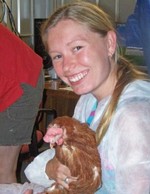Former Poultry CRC Student Reducing Fear in Hens
Published: January 18, 2013
Source : Poultry CRC
Dr Lauren Edwards undertook her PhD, titled Human-animal interactions in the laying hen, with support from the first round Australian Poultry CRC (2003-2009) under the supervision of Professors Paul Hemsworth and Grahame Coleman. Now employed as a lecturer in Applied Animal Behaviour and Welfare at Unitec Institute of Technology in New Zealand, Lauren’s research results suggest that the human-animal relationship is very important for laying hens, particularly with regard to welfare and performance.

It has long been established that poultry are innately fearful of humans, and that farm animals experiencing fear in the presence of stockpeople suffer from reduced welfare and productivity due to repeated exposure to this stressor. Lauren has researched human-animal relationships in commercial cage-layer facilities both here in Australia and in the USA. Her research has focussed on relationships between hen avoidance behaviour and duration/proximity of human workers to cages, the behaviour and attitude of stockpersons and flock productivity. Non-invasive albumen corticosterone levels have been recorded as a measure of stress in hens.
In her recent research on stockperson attitude, Lauren found that “in general, negative stockperson attitudes were associated (P < 0.05) with more noise, faster speed of movement, less time spent stationary, and less time in the ends of the aisles. Positive attitudes and empathy were associated (P < 0.05) with less noise, although there were fewer significant relationships for these attitudes.” Lauren explains, “These attitude-behaviour relationships for stockpeople working in the egg industry suggest a sequential human-animal relationship, in which stockperson attitudes may influence the welfare of laying hens.”
Lauren found that hens displayed greater avoidance behaviour in laying houses where the stockpeople made more noise, and less avoidance behaviour in laying houses where stockpeople spent more time standing stationary in front of the cages. Her research results have consistently suggested that close proximity of visual human contact is effective in reducing the behavioural response of hens to human contact. Interestingly, the duration of human contact was found not to be a significant factor.
For industry, the outcomes of this research are simple and easy to adapt into everyday practice. As Lauren sums up, “Stockpeople should consider how their behaviour influences birds, and physically work more closely to the cages to reduce fear of humans in their flock.”
Source
Poultry CRCRelated topics
Mentioned in this news release:
Join to be able to comment.
Once you join Engormix, you will be able to participate in all content and forums.
* Required information
Would you like to discuss another topic? Create a new post to engage with experts in the community.
Create a post
.jpg&w=3840&q=75)